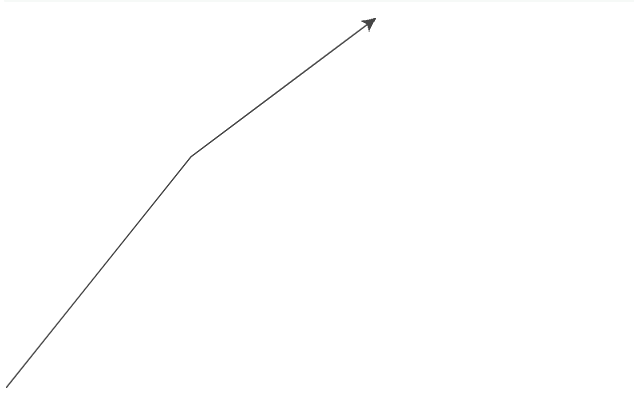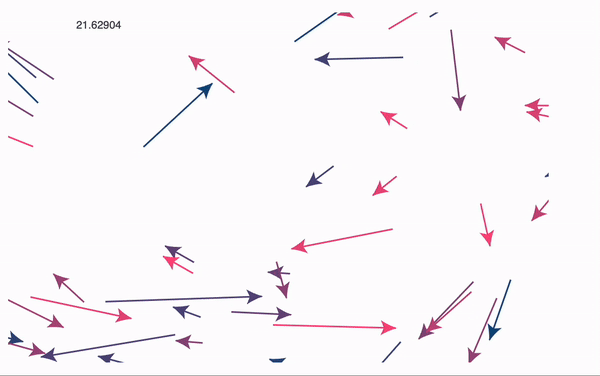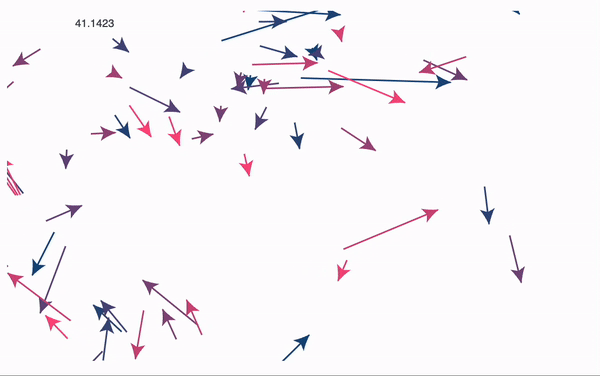Performance Tips
Post processing on frontend
For instance you are passing some symbol vec to Graphics primitive and would like to change the order of elements or rescale it.
Good approach 👍🏼
vec = {1,1};
Graphics[{
Arrow[{{0,0}, vec, 2 {vec[[1]], 0.8 vec[[2]]}} // Offload]
}]

This will work, but will be slightly inefficient when it comes to large arrays of data or multiple copies of Arrow.
Try to minimize to a single instance of vec :
Best approach 👌
vec = {1,1};
Graphics[{
Arrow[With[{x = vec}, {{0,0}, x, {2 x[[1]], 1.6 x[[2]]}}] // Offload]
}]
Then if you set vec = RandomReal[{0,1}, 2] it will only cause 1 revaluation of vec instance.
Think of an onion from the Shrek movie!
Possible wrong solution
You might try to do the following ❌
Graphics[{
With[{x = vec}, Arrow[{{0,0}, x, {2 x[[1]], 1.6 x[[2]]}}]] // Offload
}]
It won't work, since the binding between vec and Arrow isn't possible. Arrow simply does not see its outer expressions.
The syntax
{2, 1.6} x }]] // Offload
is not yet supported by WLJS Interpreter, but absolutely valid for Wolfram Language. Please do this instead if you place it inside Offload
{2 x[[1]], 1.6 x[[2]]} }]] // Offload
Multiple symbols to 1 primitive
Sometimes you need to controls two parameters at the same time. Then one can write something like this
Graphics[{
Disk[pos // Offload, radius // Offload]
}]
It will still work, but it depends how you update pos and radius. If they are completely independent in terms on time it makes sense to couple them to Disk equally.
Optimization
However, if you always update pos and radius at the same time, you might rewrite it as follows ✅
Graphics[{
Disk[pos // Offload, Offload[radius, "Static"->True]]
}]
It might be misleading, but here setting a new value to radius won't cause re-evaluation of Disk. Then you can update two as
radius = newRadius; (* only sync *)
pos = newPos; (* sync + re-evalaution of Disk *)
Here order matters, if you flip it Disk might still use radius values from the previous update (1 step lagging behind pos).
Tables of data
You can explicitly choose what will be interpreted on the frontend or backend. There are a few possibilities for our function inside the Line expression.
Full Load on the Kernel ✅
The simplest, universal and robust solution
EventHandler[InputRange[0,4,0.1], Function[data,
lines = With[{y = data},
Table[{Cos[x], Sin[y x]}, {x,0,2Pi, 0.01}]
]
]];
% // EventFire (* Just to initialize *)
The last line manually fires an event to initialize the symbol lines. Then, for the output, we can write:
Graphics[{Cyan, Line[lines // Offload]}]
This binding can be illustrated as shown in the image below:
Math operations for free
You can apply any basic operation on the data on the frontend almost for free
Graphics[{Cyan, Line[2 lines // Offload], Line[lines // Offload]}]
Then you have two sets of lines, each binds to its own instance of lines symbol. It won't cost extra in terms of bandwidth of the communication channel between frontend and backend.
Using the Frontend
One can move the entire Table computation to the browser's side (WLJS Interpreter). Let's discard our previous changes:
EventHandler[InputRange[0,4,0.1], Function[data,
v = data
]];
% // EventFire
Naive Approach 1 ❌
A straightforward solution for output could be:
Graphics[{Cyan, Line[
Table[{Cos[x], Sin[Offload[v] x]}, {x,0,2Pi, 0.1}]
]}]
This would be a terrible solution 👎🏼
Each time the Table iterator x goes through the range of values, it creates a sublist of Sin and Cos functions that contain the dynamic variable v. This results in multiple instances of v.
Line[Table[Expression[Offload[symbol]], {i, 10}]]
Creates 10 instances of symbol. The Line function will be called 10 times on each update of symbol!
Avoid placing dynamic symbols inside large Table expressions. Minimize the number of copies created.
Naive Approach 2 ❌
Let's try to improve it a bit:
Graphics[{Cyan, Line[
Table[{Cos[x], Sin[v x]}, {x,0,2Pi, 0.1}] // Offload
]}]
This is also inefficient 👎🏼 The Table function still runs on the browser's side and each time v gets an update it re-evaluates the whole table
Optimized Version ✅
One can reduce the number of instances to just one using With, as shown in the example above:
Graphics[{Cyan, Line[
With[{y = v},
Table[{Cos[x], Sin[y x]}, {x,0,2Pi, 0.01}]
] // Offload
]
}]
This saves a lot of resources 👍🏼
Line[With[{y = symbol}, Table[AnyBasicExpression[y], {i, 10}]]]
Creates only 1 instance of symbol. The Line function will be called once per update of symbol.
Line[symbol//Offload], ... Line[symbol//Offload]
This is acceptable since each Line is bound to its own symbol instance. Therefore, on an update of symbol, each Line expression will be reevaluated once.
A Possible Pitfall with With
There might be a temptation to wrap the Line expression inside With, like this:
Graphics[{Cyan, With[{y = v},
Line[
Table[{Cos[x], Sin[y x]}, {x,0,2Pi, 0.01}]
]
] // Offload}]
This will not work at all 👎🏼 because the binding will occur between Graphics and v objects.
Think of an onion from the Shrek movie!
Numeric Arrays
It is usually done automatically by Wolfram Language if the data has been generated using pure functions with Map, RandomReal, Table and etc.
When transferring points as nested lists, it is better to wrap them in NumericArray. This informs the WLJS Interpreter in the browser that only numbers or lists of numbers are expected, reducing the load during parsing.
For example, using dynamic symbols:
(* Every update *)
symbol = someFunctionThatReturnsList
20 FPS

By using NumericArray:
(* Every update *)
symbol = NumericArray[someFunctionThatReturnsList]
~40 FPS





